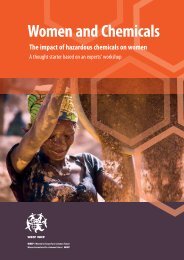future now”
YAO19
YAO19
You also want an ePaper? Increase the reach of your titles
YUMPU automatically turns print PDFs into web optimized ePapers that Google loves.
emaining active. This has prompted them to follow a<br />
different route and create their own safe spaces, like women’s<br />
groups, to address the needs generated from such a<br />
radically changed situation.<br />
In 2014, three more women’s groups in Aleppo and Al-<br />
Hasaka and one in Deir Ezzor were founded.<br />
Although the research only includes half of 2015, there<br />
appears to be a decrease in the establishment of women’s<br />
groups this year, with only two emerging, both located in<br />
the northern countryside of Aleppo. Given that the groups<br />
were only recently founded, their activities are still few.<br />
One group aims to document violations against women<br />
perpetrated by all the warring parties and provides shelter<br />
for women survivors of war, while the other focuses on<br />
advocating children’s and women’s rights and implementing<br />
literacy campaigns.<br />
Participants in a gender workshop in the countryside of Aleppo. On<br />
the wall is a quote by Simone de Beauvoir. It says, “One is not born,<br />
but rather becomes, a woman”.<br />
Photo: Badael Foundation<br />
Age dynamics and group size<br />
A majority of the women’s groups members are between<br />
31 and 50 years old (see Figure 3). This marks quite a difference<br />
compared to civil society organizations (CSOs) in<br />
Syria in general, where research shows that 74 percent<br />
of the members are between 16 and 30, a much younger<br />
average 11 . Within the women’s groups, members between<br />
16 and 30 only constitute 42 percent. Similarly, CSOs in<br />
general only have 8 percent of members between the ages<br />
of 41 and 50, although it is the second largest age group<br />
within the women’s groups. Possible reasons for these distinctive<br />
differences are further discussed in Chapter Four<br />
under Individual Efforts.<br />
When looking at administrative staff, members and volunteers<br />
(hence, all included in the term “members”),<br />
what stands out is that the women’s groups are mostly<br />
relatively small in size 12 . 18 groups have a maximum of 16<br />
members, and 17 groups have between 17 and 32, making<br />
the average group size 20. The lowest number was found<br />
in one group in a Damascus suburb (two members), while<br />
the maximum number (200 members) was held by one<br />
group in Daraa (see Figure 4).<br />
Some of the women’s groups stated that having a small<br />
number of staff negatively affected their work and its sustainability.<br />
Some attributed these low numbers to a lack<br />
of funding, others to the dangers and threats imposed by<br />
war which forces people to flee the country.<br />
Number of members<br />
400<br />
Figure 3: Age structure of women’s groups<br />
350<br />
300<br />
364<br />
344<br />
250<br />
200<br />
150<br />
238<br />
269<br />
100<br />
50<br />
0<br />
15<br />
58<br />
60<br />
12<br />
40<br />
2<br />
Years



